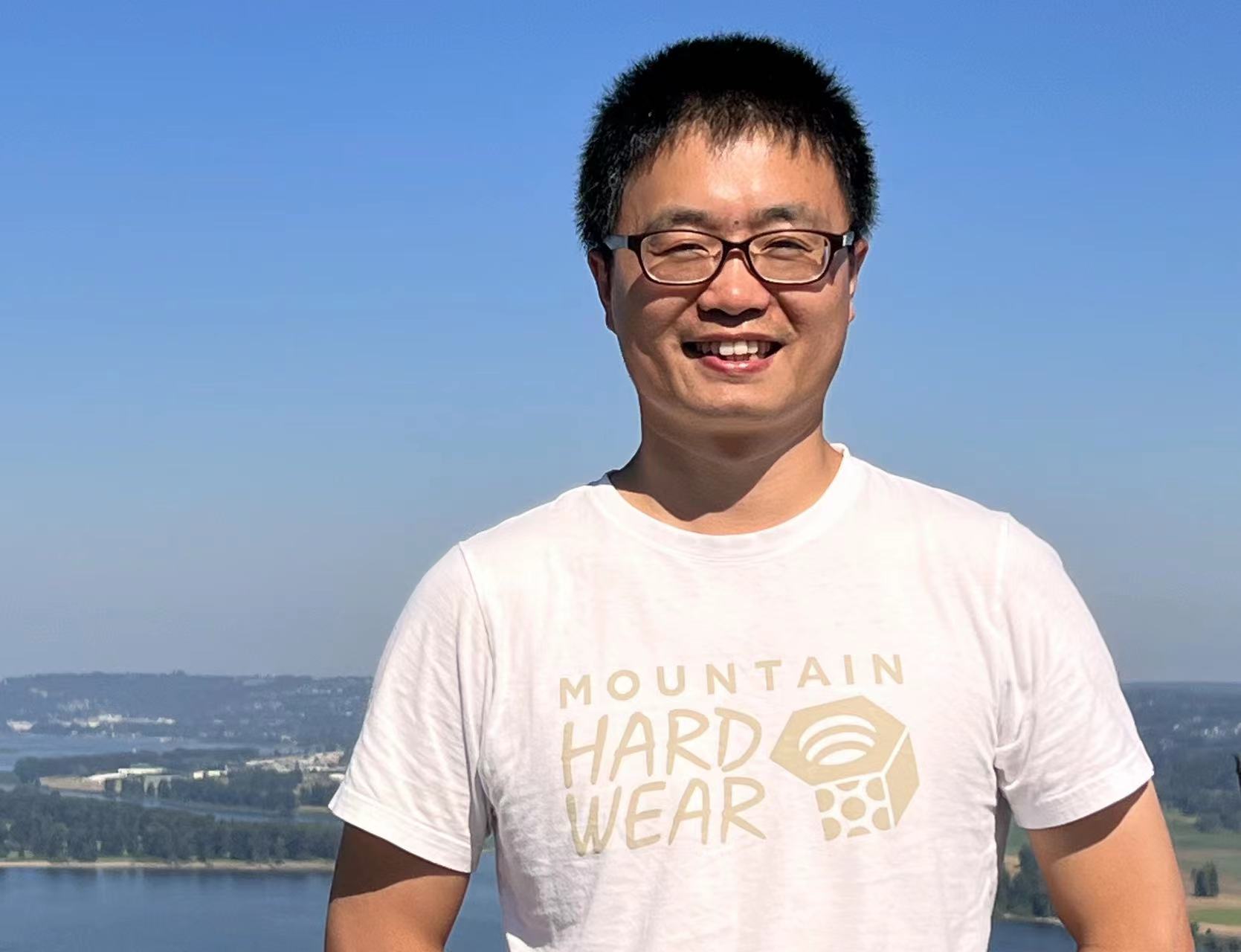朱洪涛

简介:
1987年出生于山东潍坊。2009年本科毕业于中国海洋大学海洋技术专业(声学)。2014年博士毕业于中国科学院生物物理研究所朱平研究组。2014-2015年在中国科学院生物物理研究所朱平组担任助理研究员。2015-2022年加入美国俄勒冈健康与科学大学Vollum 研究所Eric Gouaux研究组(霍华德休斯医学研究所)攻读博士后。2022年11月加入中国科学院物理研究所软物质实验室,任特聘研究员,博士生导师,国科大双聘教授。
"The best way to have a good idea is to have lots of ideas." --by Linus Pauling
主要研究方向:
冷冻电镜技术在结构生物学研究领域具备得天独厚的优势。近几年,借助于软件和硬件的飞速发展,研究者可以使用极低浓度的蛋白质快速得到近原子分辨率的蛋白质结构,并且容易获得处于不同功能状态下的蛋白质结构,因此冷冻电镜技术已经成为最主要的结构生物学技术手段。本实验室主要利用冷冻电镜技术来研究与人类疾病相关的重要蛋白质的高分辨率结构,同时结合其他的生物物理技术比如单分子荧光技术、电生理技术等广泛而全面的研究此类蛋白的功能,从而深入理解疾病发生的分子机理。
代表性论文及专利:
代表性文章(*第一作者/共同第一作者;$通讯作者):
17. Li,X.*, Liu, Y.*, Han, J. Zhang, L., Liu, Z. Wang, L., Zhang, S., Zhang, Q., Fu, P., Yin, H., Zhu, H.$ and Zhang, H.$ (2024) Structural basis for the type I-F Cas8-HNH system. EMBO J. https://www.embopress.org/doi/full/10.1038/s44318-024-00229-8
16. Liu, Y.*, Wang, L.*, Zhang, Q.*, Fu, P., Zhang, L., Zhang, H.$ and Zhu, H.$ (2024) Structural Basis for RNA-guided DNA degradation by Cas5-HNH/Cascade complex. BioRxiv. https://www.biorxiv.org/content/10.1101/2024.07.22.604555v1
15. Gao, X.*, Zhu, K.*, Wang, L.*, Shang, K., Hua, L., Qin, B., Zhu, H.$, Ding, W.$, and Cui, S.$ (2024) Structural basis for the interaction between human coronavirus HKU1 spike receptor binding domain and its receptor TMPRSS2. Cell Discovery. https://www.nature.com/articles/s41421-024-00717-5
14. Lu, J*., Fang, J, Zhu, H., Liang, L., Khudaverdyan, N., Song, J$. (2023) Structural basis for the allosteric regulation and dynamic assembly of DNMT3B. Nucleic Acids Research. https://doi.org/10.1093/nar/gkad972
13. Gao, X.*, Shang, K.*, Zhu, K.*, Wang, L.*, Mu, Z.*, Fu, X., Yu, X., Qin, B., Zhu H.$, Ding, W$ and Cui, S$. (2023) Nucleic acid-triggered NADase activation of a short prokaryotic Argonaute. Nature. https://doi.org/10.1038/s41586-023-06665-6
12. Sun, C., Zhu, H., Clark, S., Gouaux, E$. (2023) Cryo-EM structures reveal native GABAA receptor assemblies and pharmacology. Nature. https://doi.org/10.1038/s41586-023-06556-w
11. Zhu, H.*$ (2022). Structure and Mechanism of Glycine Receptor Elucidated by Cryo-Electron Microscopy. Frontiers in Pharmacology 13. Invited Review.
10. Ivica, J*., Zhu, H*., Lape, R., Gouaux, E.$, and Sivilotti, L.G$. (2022). Aminomethanesulfonic acid illuminates the boundary between full and partial agonists of the pentameric glycine receptor. Elife 11, e79148.
9. Zhu, H.* and Gouaux, E$. (2021). Architecture and assembly mechanism of native glycine receptors. Nature 599, 513-517.
8. Ivica, J., Lape, R., Jazbec, V., Yu, J., Zhu, H., Gouaux, E., Gold, M.G., and Sivilotti, L.G$. (2021). The intracellular domain of homomeric glycine receptors modulates agonist efficacy. Journal of Biological Chemistry 296.
7. Yu, J.*, Zhu, H.*, Lape, R., Greiner, T., Du, J., Lü, W., Sivilotti, L.$, and Gouaux, E$. (2021). Mechanism of gating and partial agonist action in the glycine receptor. Cell 184, 957-968. e921.
6. Phulera, S*., Zhu, H.*, Yu, J.*, Claxton, D.P., Yoder, N., Yoshioka, C., and Gouaux, E$. (2018). Cryo-EM structure of the benzodiazepine-sensitive α1β1γ2S tri-heteromeric GABAA receptor in complex with GABA. Elife 7, e39383.
5. Zhu, H.*, and Zhu, P.$ (2015). No longer'blob-ology': Cryo-EM is getting into molecular details. Science China. Life Sciences 58, 1154.
4. Zhuang, J.*, Coates, C.J$., Zhu, H., Zhu, P., Wu, Z., and Xie, L$. (2015). Identification of candidate antimicrobial peptides derived from abalone hemocyanin. Developmental & Comparative Immunology 49, 96-102.
3. Zhu, H.*, Zhuang, J.*, Feng, H., Liang, R., Wang, J., Xie, L.$, and Zhu, P.$ (2014). Cryo-EM structure of isomeric molluscan hemocyanin triggered by viral infection. Plos one 9, e98766.
2. Jiao, L*., Ouyang, S., Shaw, N., Song, G., Feng, Y., Niu, F., Qiu, W., Zhu, H., Hung, L.-W., Zuo, X, Shtykova V., Zhu P., Dong Y., Xu, R.$, and Liu Z$. (2014). Mechanism of the Rpn13-induced activation of Uch37. Protein & cell 5, 616-630.
1. Gong, M.*, Zhu, H.*, Zhou, J., Yang, C., Feng, J., Huang, X., Ji, G., Xu, H.$, and Zhu, P.$ (2014). Cryo-electron microscopy study of insect cell-expressed enterovirus 71 and coxsackievirus a16 virus-like particles provides a structural basis for vaccine development. Journal of Virology 88, 6444-6452.
目前的研究课题及展望:
1. 内源性异聚甘氨酸受体信号传递的分子机制研究。
甘氨酸受体是广泛存在于中枢神经系统中的抑制性受体,是由五个亚基组成的氯离子通道。甘氨酸受体的功能异常会引起非常严重的神经系统紊乱,会导致诸多疾病包括抑郁症、惊吓症等。同时,甘氨酸受体还是镇痛剂和麻醉剂的潜在作用靶点。在此课题中,我们计划从动物组织中提取内源性甘氨酸受体,并尝试挖掘与甘氨酸受体结合的潜在小分子药物,并进一步解析近原子分辨率的蛋白质结构。下图展示的是内源性甘氨酸受体的结构(Zhu et al., Nature,2021)。

2. 锌离子激活和转运相关的结构与功能研究。
锌离子是人体必须的微量元素,锌离子的稳态失衡会引起免疫系统和神经系统的众多疾病,比如免疫力下降、癫痫、记忆力衰退、抑郁症等。在此课题中我们将会聚焦于人类癌症相关的锌离子的转运和调控机制。我们选择与锌离子转运相关的蛋白质为切入点,并逐步探索锌离子的调控机理。
3. 其他有意义的生物大分子的结构生物学研究。
本课题组非常欢迎与其他课题组开展合作,合力探索并解析对人体生命活动起到重要作用的蛋白质的高分辨率结构。
目前的基金项目:
- 中国科学院引进人才I类项目, 项目负责人,2022年立项。
- 国家某海外高层次人才计划项目, 项目负责人,2023年立项。
- 中科院择优计划支持项目,项目负责人,2023年立项。
- 国家基金委面上项目,项目负责人,2024年立项。
培养研究生情况:
拟每年招收研究生(硕博连读生或博士生)1-2名,学术背景不限。长期招聘博士后,学术背景倾向于生物物理学或者生物化学。
实验室目前人员:
吴艳云 (科研助理;2023年入所)
王琳(博士后;2022年入站)
刘亚男 (博士后;2023年入站)
潘成才 (科研助理;2023年入所)
杨鑫雨 (科研助理,2024年入所)
孙雅雪 (硕士生;2022年入学)
贺宇航 (硕士生;2023年入学)
张海中石 (硕士生;2023年入学)
罗梦诗 (博士生;2024年入学)
张悦雯 (硕士生;2024年入学)
其他联系方式:
座机:(010)82649445
办公室: A楼429
电话:
010-82649445
Email:












